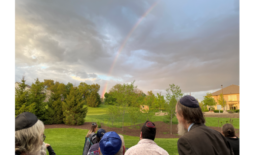Hotspots of Holiness
Who of you remembers that childhood game where a friend would hide something in the house and you would be charged to find it? Your playmate would give you purposely obtuse instructions, like ‘hot’ or ‘cold’—or ‘hotter’ and ‘colder’ once you homed in on your search. I loved that game: there was the tingling thrill of the search but there was also a superimposition of an imaginary map onto familiar space, reassigning meaning to the ordinary. All of a sudden, the home was energetically divided into zones and hotspots; the peripheries and the centers—a holographic sense of sacred space.
I will now give you an advance warning: this is a philosophical, contemplative sermon so sit back and enjoy the journey!
Returning to our metaphor of hotspots of holiness, we can apply this more broadly as we find = these hotspots in our lives and our surroundings. There are places in our house where we feel comfort and wellbeing more acutely. We may have a visceral response to creepy basements and dusty attics, to inviting courtyards and sumptuous gardens, to living rooms anchored by a roaring hearth, centering the home. These perceptions are intuitive rather than explicit but they are formative in terms of how we navigate space and find meaning in it.
Of course, we can extend the metaphor even further: to communities, streets, neighborhoods, cities, nations and our world, perhaps even our corner of the galaxy. The human mind is wired to see patterns and read meaning into those patterns. It’s how we make sense of our world. This human propensity has had tremendous impact on how we design space; artistically, architecturally and spiritually. We see this in the enduring symbols of our culture: the National Mall in Washington DC or, closer to home, the Pentacrest in Iowa City. The constellations of centers and peripheries are like fractals; once you recognize their mathematics, you notice them everywhere.
When studying the Book of Numbers in the Torah, we often focus on the demographic quality of the portion. We read reams of tribal names and an accounting of the (male) leadership and membership of each of the twelve tribes. The Book of Numbers at large is preoccupied with demographics: who counts? Who does the counting? Who is accountable? And who is discounted?
From the text, we get a pervasive sense of hierarchy and order as the Torah describes in minute detail how the tribes march in formation, led by the eastern and southern flanks of Yehudah and Reuven. This a text focused on people but also on position. The Parashah reveals its own ‘hotspots’, its centers and peripheries, its way of understanding and structuring the world. With the Tabernacle at the center and the ministering Levitical Priests surrounding it, the ‘axis mundi’, the existential core on which cosmic existence relies, is clear.
The casual reader of the Torah may wonder why this matters. We have survived the arcane descriptions of Leviticus only to be thrown into, well, more arcane descriptions of Numbers. The inner cultural anthropologist in me believes that it matters a great deal, not only because this is a conceptualization of populations and positioning, but the mapping, perhaps of something more primordial: our inner world of the human psyche.
A number of months ago, congregant Andrea Chase in a D’var Torah of her own, drew a startling and powerful analogy when she was examining the inauguration of the Tabernacle. She described the concentric circles of holiness as a Biblical literary and visual ‘Mandala’—the Dharmic geometric artform used as a meditative device and spiritual portal in Buddhism and Hinduism. I was so struck by her insight that I am teaching this Torah ‘b’shem omrah’, in her name, and I would argue that we are seeing a similar phenomenon here. In an ancient and chaotic world, applying order and sanctification of time and place, community and God, would have anchored ancient Israelites in a sense of safety, familiarity and meaning. In short, the map of the Tabernacle, the formations of the tribes, point back in time at the ordering of cosmic creation.
It may not be so different for us.
Paradoxically, this obsession with order occurs at a narrative point in the Torah where things are really going to go off the rails—this part of the Torah is brimming with discontent and conflict and every other known human vice. Bamidbar translates as ‘wilderness’ (often mistranslated as ‘desert’). Wildernesses are places that exist beyond the boundaries of human civilization. They are wild, uncontrolled and unpredictable. They are the last remaining repositories of primordial chaos. In a sense, we can understand the ‘hotspots’ of Bamidbar, the ‘center and periphery’ of the world of the Book of Numbers, as an enduring battle between the forces of chaos and order. If we read this story not just as our people’s collective story but also as the mind-map of our own spirit, then what are the wild and open spaces in our own lives? What is the ‘tohu vavohu’, the unformed void of our own experience? And how do we find the ‘Ruach Elohim’, the Divine Spirit hovering over it, steadily transmuting anarchy into creativity? These reflections help us uncover a deep knowing about ourselves and our place in the world.
We all yearn for places of safety and belonging where we can feel grounded and centered. The subtle layers of holiness and meaning that we peel away in the intimate spaces of our own lives. The rootedness of a well-loved kitchen table or reading nook; the spiritual pull of a historic house of worship or this beautiful bimah. The centrality of sacred civic spaces, be they a public library, a school or the halls of power. We are called to appreciate and reclaim those spaces from chaos and discontent. We are invited to think anew of the relationships in our lives where we center love rather than conflict, belonging and connection rather than alienation and loneliness. The Israelites organized themselves in formation but they did not slip into stasis: they moved their sacred ‘machaneh’, ‘encampment’, in tribal units three-by-four, always orienting themselves to the beating heart of the covenant: the Tabernacle.
I pray that all of us can tap into ancient wisdom and that we too, can find places of clarity, sanctity and peace among the rugged wilds of the human condition.





